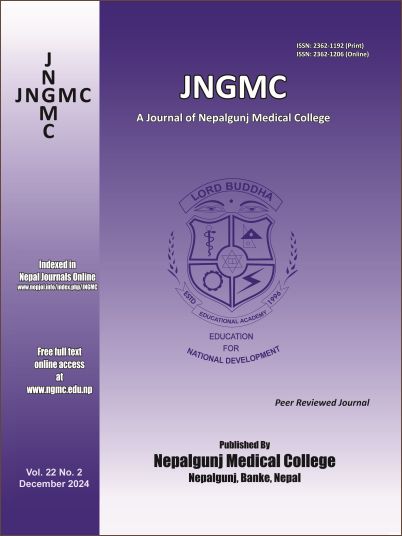Assessment of Prescribing Pattern of Antidepressants in Patient Suffering from Depressive Disorder Visiting the OPD at a Tertiary Care Teaching Hospital
DOI:
https://doi.org/10.3126/jngmc.v22i2.74350Keywords:
Antidepressant drugs, drug utilization, Escitalopram, Fluoxetine, SSRI, SNRIAbstract
Introduction: Depression is a prevalent condition that strongly affects the quality of life, academic performance, social behavior, family life, and workplace productivity. Treatment of depression, is of paramount importance and it can be achieved by proper and judicious use of antidepressant drugs.
Aims: To assess drug utilization patterns of antidepressant drug & their relevant classes to understand the drug practicing behavior of antidepressant drugs.
Methods: A descriptive cross sectional study was conducted on 159 patients visiting outpatient Department of Psychiatry at Nepalgunj Medical College Teaching Hospital after obtaining the Ethical Clearance. Patients that were eligible as per the inclusion criteria were selected for the study. All the relevant data such as demographic information, drug names, their class, route of intake was collected from the prescription card of the patient on a preformed proforma.
Results: Total of 237 drugs were prescribed, belonging to four different classes of antidepressants to total 159 patients among which Selective Serotonin Reuptake Inhibitors (44.65%) followed by serotonin and norepinephrine reuptake inhibitors (23.27%) were most highly prescribed. Escitalopram (18.98 %) was most frequently utilized among all existing antide- pressants. Antidepressant prescribed from National list of Essential Medicine (NELM), Nepal was just 34.59 % of total prescription.
Conclusion: Selective Serotonin Reuptake Inhibitors was the commonly prescribed group of antidepressant drugs and Escitalopram was prescribed in highest number for treatment of depression. The drug prescribing habits was rationale as per WHO prescribing indi- cators except underutilization of antidepressant drugs from NLEM and the complete absence of Generic drug from the prescription.
Downloads
Downloads
Published
How to Cite
Issue
Section
License
Copyright (c) 2024 Journal of Nepalgunj Medical College

This work is licensed under a Creative Commons Attribution-NonCommercial-NoDerivatives 4.0 International License.
- Attribution - You must give appropriate credit, provide a link to the license, and indicate if changes were made. You may do so in any resonable manner, but not in any way that suggests the licensor endorses you or your use.
- Non Commercial- The materials cannot be used for commercial purposes.
- No Derivatives- If the material is remixed or transformed or built upon, the modified material cannot be distributed.




